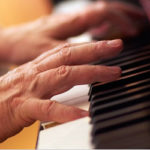
As online courses spike in popularity across the nation, students are finding that even the most traditional face-to-face courses offer virtual options that are just as thorough as in-person classes—and music instruction courses soon could follow suit.
This past spring, Louisiana State University (LSU) and the University of California, Los Angeles (UCLA) partnered for a remote piano teaching demonstration using technologically enhanced pianos from Yamaha.
During the demonstration, LSU connected a Yamaha Disklavier IV piano over the internet with another Disklavier at UCLA. The demonstration featured a mini-master class with LSU School of Music professor Michael Gurt teaching a UCLA piano student, UCLA visiting associate piano professor Jennifer Snow interacting with an LSU piano student, and LSU graduate students in piano pedagogy teaching a UCLA undergraduate student.
Such a program could have great implications for aspiring music students and professors alike.
“This has big potential for us at the university level. We’ve wanted to do this for a few years. I’m very intrigued by it,” said Pamela Pike, assistant professor of piano pedagogy at LSU. “Yamaha experts have demonstrated this long-distance teaching at professional conferences, [but] this is the first time that faculty at a university have engaged in this type of long-distance teaching.”
Music educator, clinician, author, performer, and music software developer George Litterst led the LSU demonstration. He showed that while the Disklavier looks like an ordinary piano, it is digitally enhanced and uses a musical instrument digital interface program (MIDI) to communicate with another Disklavier.
The pianos’ audio signals are transferred through the connection. Also, through the use of optical sensors, keys played on one piano show up as being played on the other, as well as pedals being depressed.
“It is an acoustic piano. It has hammers and strings and must be tuned, just like a regular piano,” Litterst said. “But, it has something regular pianos don’t—the ability to record and play back and to be connected to other Disklaviers.”
Litterst and Snow have been part of a multinational team working on behalf of Yamaha to help develop the remote learning program. Other members of the program are located in Texas, Minnesota, and Colorado, as well as in Toronto.
“There are many ways the piano can connect,” Litterst said. “For this demonstration, we used a built-in program called Remote Lesson. The program has been evolving over the past few years. We’re still working on some aspects of the software and hardware, such as microphone audio cancelation.”
Litterst said the schools used a telephone-based internet connection during the demonstration to link the two pianos, and operated the connection through the use of a smart phone that calls the IP address of the other piano to connect.
“Basically, we’re making a piano-to-piano telephone call,” he said.
Video cameras at each location, connected through the Apple iChat program for this demonstration, also allowed participants to communicate, as well as to see hand positions, arm movements, and musical gestures during performances. Litterst said popular video conferencing programs such as Skype or iChat can be used to provide visuals for Disklavier connections.
The idea to hold a demonstration came several months ago, Pike said, as she and LSU School of Music and Dramatic Arts Dean Laurence Kaptain attended a conference that featured Yamaha representatives, including Litterst.
Kaptain “really encouraged us to go for this and have a demo here at LSU,” Pike said. Rafe O’Neill, owner of local music store O’Neill’s Music House, and Litterst joined the efforts.
Pike said the options are vast for such a program at LSU, with benefits that reach throughout Louisiana and beyond.
“We could have professors here like Michael Gurt teach others across the area and state, including potential students, which makes it a great recruiting tool,” Pike said. “This also offers good teaching opportunities for our students interested in music education, who can use this for internship teaching. LSU can also collaborate with other universities to teach and share and create a much richer experience.”
From her classroom in Los Angeles, Snow expressed her excitement about the program and being able to connect with LSU as part of the demonstration.
“I’m thrilled that we’re able to do this,” she said. “I spoke with Dean Kaptain, who showed great interest in such a program. It’s a terrific way for us to share knowledge, whether it’s through practice, teaching, or reflecting back and forth—even though we’re thousands of miles apart.”
- As workers seek guidance on AI use, employers value skilled graduates - December 9, 2024
- Community colleges meet demand for skills-based pathways - December 4, 2024
- Leveraging AI is helping institutions meet goals - November 29, 2024
